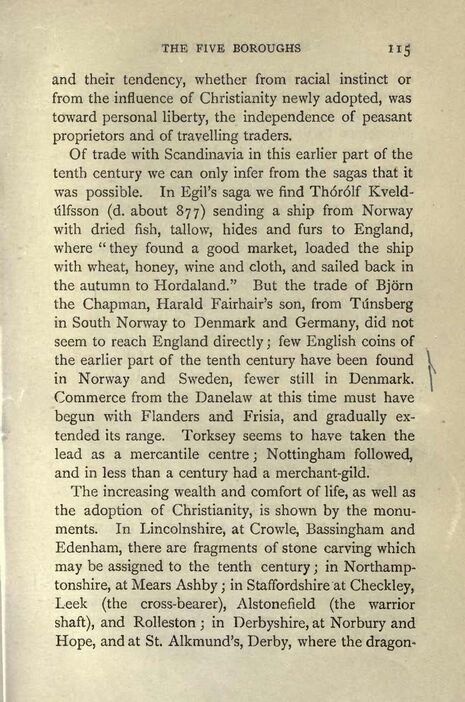
Full resolution (JPEG) - On this page / på denna sida - Scandinavian Britain - II. The Danelaw - 3. The Five Boroughs

<< prev. page << föreg. sida << >> nästa sida >> next page >>
Below is the raw OCR text
from the above scanned image.
Do you see an error? Proofread the page now!
Här nedan syns maskintolkade texten från faksimilbilden ovan.
Ser du något fel? Korrekturläs sidan nu!
This page has been proofread at least once.
(diff)
(history)
Denna sida har korrekturlästs minst en gång.
(skillnad)
(historik)
and their tendency, whether from racial instinct or
from the influence of Christianity newly adopted, was
toward personal liberty, the independence of peasant
proprietors and of travelling traders.
Of trade with Scandinavia in this earlier part of the
tenth century we can only infer from the sagas that it
was possible. In Egil’s saga we find Thórólf Kveldúlfsson
(d. about 877) sending a ship from Norway
with dried fish, tallow, hides and furs to England,
where "they found a good market, loaded the ship
with wheat, honey, wine and cloth, and sailed back in
the autumn to Hordaland." But the trade of Björn
the Chapman, Harald Fairhair’s son, from Túnsberg
in South Norway to Denmark and Germany, did not
seem to reach England directly ; few English coins of
the earlier part of the tenth century have been found
in Norway and Sweden, fewer still in Denmark.
Commerce from the Danelaw at this time must have
begun with Flanders and Frisia, and gradually extended
its range. Torksey seems to have taken the
lead as a mercantile centre ; Nottingham followed,
and in less than a century had a merchant-gild.
The increasing wealth and comfort of life, as well as
the adoption of Christianity, is shown by the monuments.
In Lincolnshire, at Crowle, Bassingham and
Edenham, there are fragments of stone carving which
may be assigned to the tenth century ; in Northamptonshire,
at Hears Ashby ; in Staffordshire at Checkley,
Leek (the cross-bearer), Alstonefield (the warrior
shaft), and Rolleston ; in Derbyshire, at Norbury and
Hope, and at St. Alkmund’s, Derby, where the dragon-design
<< prev. page << föreg. sida << >> nästa sida >> next page >>